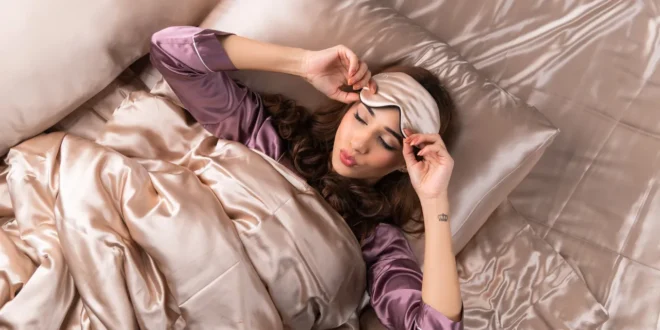In the quest for better sleep and healthier skin, many people are turning to silk pillowcases. Known for their luxurious feel and numerous benefits, silk pillowcases are more than just a trendy addition to your bedroom decor. They offer practical advantages that can enhance your overall well-being. This guide explores why silk pillowcases are worth the investment, their benefits, and answers to common questions.
What is a Silk Pillowcase?
1. Definition and Material
Overview:
A silk pillowcase is a pillow cover made from silk fabric, often produced from the fibers of the mulberry silkworm. Silk is a natural protein fiber that is both smooth and breathable, offering a unique texture compared to traditional cotton or polyester pillowcases.
Types of Silk:
- Mulberry Silk: The highest quality silk, produced by silkworms fed on mulberry leaves.
- Tussah Silk: A less refined silk with a more textured feel, often less expensive.
- Habutai Silk: A lightweight, smooth silk often used for affordable silk pillowcases.
Benefits of Using a Silk Pillowcase
1. Improved Skin Health
Overview:
Silk pillowcases are renowned for their skin-friendly properties. Unlike cotton, which can absorb moisture from your skin, silk helps maintain your skin’s hydration.
Benefits:
- Reduces Friction: The smooth surface of silk reduces friction on your skin, which can help minimize the appearance of sleep lines and wrinkles.
- Keeps Skin Hydrated: Silk does not absorb moisture, which helps keep your skin’s natural oils and any applied night creams on your face.
2. Healthier Hair
Overview:
Silk pillowcases are also beneficial for hair health. The gentle texture helps prevent hair breakage and reduces frizz.
Benefits:
- Minimizes Hair Breakage: Silk’s smooth surface reduces friction, preventing hair from breaking or becoming damaged.
- Reduces Frizz: The non-absorbent nature of silk helps maintain your hair’s natural oils, reducing frizz and keeping your hair smoother.
3. Better Sleep Quality
Overview:
Silk is a breathable material that can help regulate your body temperature, making it easier to sleep comfortably.
Benefits:
- Temperature Regulation: Silk naturally adjusts to body temperature, keeping you cool in the summer and warm in the winter.
- Hypoallergenic: Silk is naturally resistant to dust mites and allergens, which can be beneficial for individuals with allergies or sensitive skin.
How to Choose the Right Silk Pillowcase
1. Consider the Silk Grade
Overview:
Silk pillowcases come in different grades and types of silk. Higher-grade silk, such as mulberry silk, is generally softer and more durable.
Tips:
- Look for 100% Mulberry Silk: For the best quality, choose pillowcases made from 100% mulberry silk.
- Check the Momme Weight: The momme weight indicates the thickness of the silk. Higher momme weights are generally more durable.
2. Choose the Right Size and Color
Overview:
Silk pillowcases are available in various sizes and colors. Choose one that fits your pillow and matches your bedroom decor.
Tips:
- Size: Ensure the pillowcase fits your pillow size, whether standard, queen, or king.
- Color: Select a color that complements your bedding. Silk pillowcases come in a range of hues from classic white to vibrant tones.
3. Care Instructions
Overview:
Proper care is essential to maintain the quality of your silk pillowcase.
Tips:
- Hand Wash or Use a Delicate Cycle: Wash in cold water with a mild detergent. Avoid using bleach.
- Air Dry: Lay flat to dry. Avoid wringing or using a dryer, as heat can damage the silk fibers.
FAQ About Silk Pillowcases
Q: Are silk pillowcases worth the investment?
A: Yes, silk pillowcases are considered worth the investment due to their benefits for skin, hair, and sleep quality. They offer a luxurious feel and can help improve overall comfort and health.
Q: Can I use a silk pillowcase if I have sensitive skin?
A: Absolutely. Silk is hypoallergenic and resistant to dust mites and allergens, making it a great choice for those with sensitive skin or allergies.
Q: How often should I wash my silk pillowcase?
A: It’s recommended to wash your silk pillowcase every 1-2 weeks to keep it clean and maintain its quality. Follow the care instructions to ensure longevity.
Q: Do silk pillowcases help with acne?
A: Silk pillowcases can help with acne by reducing friction and irritation on the skin, which may contribute to fewer breakouts. However, they should be part of a comprehensive skincare routine.
Q: Can I iron my silk pillowcase?
A: Yes, you can iron your silk pillowcase on a low setting. Be sure to use a pressing cloth and avoid high heat to prevent damage to the silk fibers.
Read more Discover Dylan Llewellyn: The Rising Star in Entertainment
Conclusion
Silk pillowcases offer a blend of luxury and practicality, making them a valuable addition to your sleep and skincare routine. With their benefits for skin and hair health, combined with their ability to enhance sleep quality, silk pillowcases are a worthwhile investment. By choosing the right silk grade and following proper care instructions, you can enjoy the many advantages that silk pillowcases have to offer.

